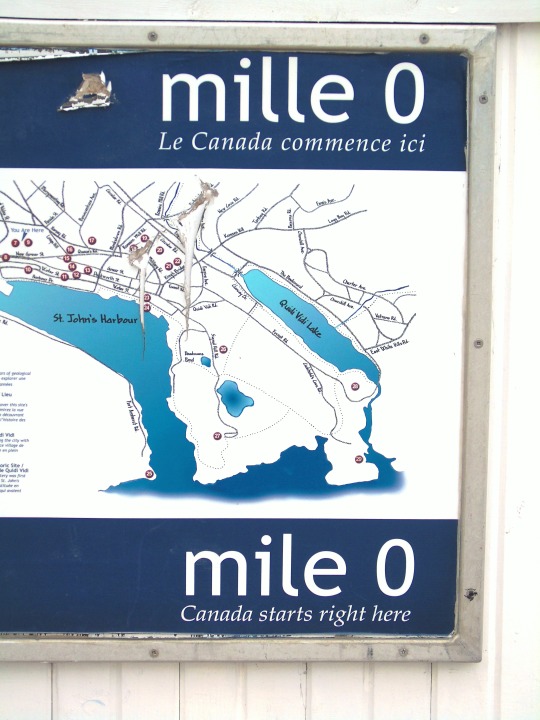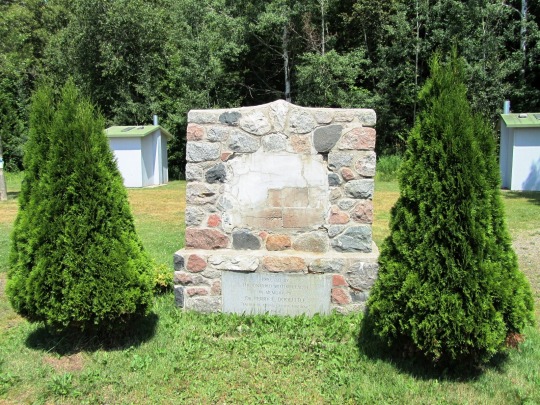#Confederation Bridge
Photo










The Trans-Canada Highway, the longest national highway in the world, was officially opened on July 30, 1962.
#Grand Falls#Confederation Bridge#St. John's#Seal Island Bridge#Canada#half way point of the Trans-Canada Highway#Park Bridge#Saskatchewan#prairie#Rocky Mountains#British Columbia#Ontario#Alberta#Newfoundland#New Brunswick#Prince Edward Island#landscape#flora#nature#tourist attraction#countryside#summer 2015#cityscape#2012#landmark#Trans-Canada Highway#opened#20 July 1962#anniversary#Canadian history
32 notes
·
View notes
Text



Confederation Bridge.
1 note
·
View note
Text
It's Been Fun, P.E.I.
It’s Been Fun, P.E.I.
Well, here we are wrapping up our seven month stay on Prince Edward Island that included six months of house sitting just outside of the small city of Summerside. The goal when coming here was two fold; to explore an area of Canada we had never been before and to experience an East Coast winter. We can safely put a big check mark in both those boxes. We travel for the experiences and the last few…

View On WordPress
#Canada#Christmas Dinner#Confederation Bridge#house sitting#PEI#Prince Edward Island#sunset#time lapse#travel#winter
0 notes
Text
I am also fascinated by the stories we tell as local urban legends that turn out to seemingly exist in every community. Warning for mention of hypothetical child death here but when I was a kid, my dad told me about these train tracks in San Antonio. He said that a school bus got stuck on the tracks and hit by a train, and that the tracks were no longer in use, but you could go and park your car on them and if you put flour all on the back of your car, you’d feel the car move and when you got out to check you’d see handprints left in the flour. Which that story FUCKED ME UP as a kid I was obsessed with it, I told it to everyone I knew, I wanted to move here so badly just to see these haunted train tracks. As an adult now I’ve seen this same story attributed to train tracks in Houston texas, as well as many towns and states all across the country, likely outside of it as well. It’s likely rooted in a single instance that did really take place but probably not as near constant as how wide spread it is makes it seem. Unless we’ve had really really shitty bus and train track protocols and kept making the same fuck up for several decades all over the country. Which isn’t too hard to believe but y know
#child death tw#sorry I just find this stuff SO interesting#this story really stuck with me as a kid I was obsessed with it#I love finding local legends and stuff like that#I live a few hours from the goat man bridge#my friends and I drive through San Marcos often and apparently that place has ghosts#my friend asked if we should be concerned about the ghost of a confederate soldier who is said to haunt an area we often pass by#and I’m like well probably not. I mean. who would win#one living multi racial friend group. or one dead confeddy loser who clearly lost both the battle and the war#San Antonio has some sick ass haunted hotels#I am in fact in love with the one that used to be a hospital#next time I’m in HEB I should pick up that haunted Texas magazine it’s always available#I don’t even really believe ghosts exist 100%#but I love the stories that come from them
1 note
·
View note
Text
This is a report by El Nuevo Día (PR’s biggest newspaper) about a local Puerto Rican org, Casa Pueblo, putting solar panels and training people at a Haitian Dominican community that is exploited by sugar mills. It’s very good despite the fact I would’ve liked to hear more from the people there than the Puerto Ricans, which can veer into white savior-y. But Arturo Massol-Deyá (Casa Pueblo’s director and a renowned scientist) makes this point, that I’ve heard from other journalists, about how Puerto Ricans benefit from exploiting Dominican workers. This isn’t new at all, PRican racism is disgusting and prevalent, but what seems to me new is that it’s moved from local exploitation to examining power relationships between the islands. Not much else to be said, except I lowkey cried when I saw the PR flag hung there. It’s certainly not necessarily good, there is a long history of white saviorism between PR and Haiti, but there’s also a sense of building bridges outside the governments and beyond colonialism that I find very hopeful.
#I thought it was interesting so yeah#No English version though :( ENDI has to step up on that#Idk i dream so badly of PR as a bridge.#Geographically it is in our nature to be a bridge bc we are the first largeish piece of land between Europe#Africa and the Americas#Ok i mean in the Caribbean lol#^ dont put much stock in that. Its 10 pm and im too tired to talk bout ramon emeterio betances antillean confederation#Which is where im coming from
0 notes
Text

Women warriors in Chinese history - Part 2
(Part 1)
"However, court confessions, unofficial histories, and local gazetteers do reveal a host of women warriors during the Qing dynasty when patriarchal structures were supposedly most influential. Women in marginal groups were apparently not as observant of mainstream societal gender rules. Daughters and wives of “peasant rebels,” that is, autonomous or bandit stockades, were frequently skilled warriors. Miss Cai 蔡†(Ts’ai) of the Nian (Nien) “army,” for example, “fought better than a man, and she was especially fine on horseback. She was always at the front line, fighting fearlessly despite the large number of government troops.” According to a folktale, she managed to rout an invading government force of several thousand with a hundred men and one cannonball after her husband led most of the Nian off to forage for food.
Related to the female bandits were the women pirates among whom Zheng I Sao 鄭一嫂†(literally, Wife of Zheng I; 1775–1844) is the best researched. “A former prostitute … Cheng [Zheng] I Sao could truly be called the real ‘Dragon Lady’ of the South China Sea.” Consolidating her authority swiftly after the death of her husband, “she was able to win so much support that the pirates openly acclaimed her as the one person capable of holding the confederation together. As its leader she demonstrated her ability to take command by issuing orders, planning military campaigns, and proving that there were profits to be made in piracy. When the time came to dismantle the confederation, it was her negotiating skills above all that allowed her followers to cross the bridge from outlawry to officialdom.”
We know slightly more about some of the women warriors involved in sectarian revolts. Folk stories passed down orally are one of the sources. Tales that proliferated in northern Sichuan on the battle exploits of cult rebels of the White Lotus Religion uprising in Sichuan, Hunan, and Shaanxi beginning in the late eighteenth century glorify several women warriors. The tall and beautiful Big Feet Lan (Lan Dazhu 籃大足) and the smart and skillful Big Feet Xie (Xie Dazhu 謝大足) vanquished a stockade together; the young and attractive Woman He 何氏 could kill within a hundred feet by throwing daggers from horseback. The absence of bound feet in Big Feet Lan and Big Feet Xie suggests their backgrounds were either very poor, unconventional, or non-Han.
Sectarian groups accepted female membership readily, and many of these women trained in the martial arts. Qiu Ersao 邱二嫂†(ca. 1822–53), leader of a Heaven and Earth Society (Tiandihui 天地會) uprising in Guangxi, joined the sect because of poverty and perfected herself in the martial arts. Some women came to the sects with skills. Su Sanniang 蘇三娘, rebel leader of another sect of the Heaven and Earth Society, was the daughter of a martial arts instructor. Such sectarian rebel bands are frequently regarded as bandit groups. A history of the Taiping Revolutionary Movement refers to these two cult leaders as female bandit chiefs before they joined the Taipings.
Male leaders of religious rebellions frequently married women from families skilled in acrobatic, martial, and magic arts. These women tended to be both beautiful and charismatic. Wang Lun 王倫, who rebelled in 1774 in Shandong, had an “adopted daughter in name, mistress in fact,” by the name of Wu Sanniang 烏三娘 who was one of Wang’s most powerful warriors. Originally an itinerant performer highly skilled in boxing, tightrope walking, and acrobatics, she terrified the enemy with spellbinding magic. She brought a dozen associates from her old life to the sect, and they all became fearsome warriors known as “female immortals” (xiannü 仙女); three of them, including Wu Sanniang, lived with Wang Lun as “adopted wives” (ifu 義婦). A tall, white-haired woman at least sixty years old, possibly the mother of one of these acrobat-turned women warriors, wielded one sword with ease and two almost as effortlessly. Dressed in yellow astride a horse, hair loose and flying, she was feared as much for her sorcery as for her military skills. Her presence indicates that some of the women came from female-dominated itinerant performing families. Woman Zhang 張氏and Woman Zhao 趙氏, wives of Lin Zhe 林哲, another leader of the cult, were also known for being able to brandish a pair of broadswords on horseback.
Hong Xuanjiao 洪宣嬌†(mid nineteenth century), also known as Queen Xiao (xiaohou 蕭后), wife of the West King of the Taiping Heavenly Kingdom (taiping tianguo 太平天國), was so stunningly beautiful and impressive in swordsmanship that she mesmerized the entire army during battles. The link between early immortality beliefs and shamanism also suggests that these women warrior “immortals” of sectarian cults may represent surviving relics of the female shamans who occupied high positions during high antiquity.
During the White Lotus Religion rebellion in Sichuan, Hunan, and Shaanxi beginning in 1796, five of the generals were at once leaders and wives of other leaders of the cult. They were Woman Qi née Wang (Qiwangshi 齊王氏; Wang Cong’er 王聰兒), Woman Zhang née Wang (Zhangwangshi 張王氏), Woman Xu née Li (Xulishi 徐李氏), Woman Fan née Zhang (Fanzhangshi 范張氏), and Woman Wang 王†née Li 李 (Wanglishi 王李氏). In the Heavenly Principle Religion (tianlijiao 天理教) rebellion that began in Beijing during 1713, the wife of its leader, Li Wencheng 李文成, led three invasions into the city. There was even a “Female Army” (niangzijun 娘子軍) within the Eight Trigrams (baguajiao 八卦教) uprising in Shandong during the Daoguang 道光† reign (1821–51). The female generals, Cheng Sijie 程四姐†and Yang Wujie 楊五姐, were particularly impressive when they wove among enemy forces in the style of “butterflies flitting among flowers,” wielding broadswords on horseback, their hairpins glittering in the light.
A number of female rebel leaders used religion and magic to buttress their power. Many claimed to be celestials and were leaders of sectarian cults (...). Chen Shuozhen 陳碩貞†(?–653) mobilized a peasants’ uprising by declaring that she had ascended to heaven and become an immortal. Tang Sai’er (ca.1403–20), a head of the White Lotus Religion (bailianjiao 白蓮教), designated herself as a “Buddhist Mother” (fuomu 佛母). The spellbinding old woman warrior in Wang Lun’s Clear Water Religion (qingshuijiao 清水教) sect was known to the rebel community as a reincarnation of the highest White Lotus deity, the Eternal Venerable Mother (wusheng laomu 無生老母). Wang Lun relied on her for performing magic and the rituals for calling on their supreme deity. Woman Wang née Liu (wangliushi 王劉氏), one of the numerous female leaders of the White Lotus Religion revolt, also titled herself the Eternal Venerable Mother. Wang Cong’er (1777–98), originally an itinerant entertainer, became the commander in chief of the rebel army she launched with her husband, a master in the White Lotus Religion.
Indeed, itinerant performers such as Wu Sanniang mentioned above were frequently trained in the martial arts since childhood and must have been skilled at performing magic tricks as well. Lin Hei’er 林黑兒†(?–1900), leader of Red Lanterns (hongdengzhao 紅燈照), the young women’s branch of the Boxer’s Movement (yihetuan 義和團), was also originally an itinerant entertainer (her husband was a boatman). Designating herself the Holy Mother of the Yellow Lotus (huanglian shengmu 黃蓮聖母), she taught her followers the skills of wielding swords and waving fans as well as magic to defeat their enemies. Wang Nangxian 王囊仙†(literally, Goddess Nang, 1778–97), an ethnic minority of the Miao tribe, was worshipped as a goddess by her tribesmen before she led them in revolt against the Chinese government."
Chinese shadow theatre: history, popular religion, and women warriors, Fan Pen Li Chen
#history#women in history#women warriors#warriors#warrior women#china#chinese history#asian history#historyblr#qing dynasty#19 century#18th century#Wang Cong’er#hong xuanjiao#su sanniang#qiu ersao#tang sai'er#asia#Zheng Yi Sao
177 notes
·
View notes
Quote
I went on across the bridge, various memories coming to mind, my footgear clattering on the floorboards. Again, I fell to dreaming. And I finally let out a sigh. Could I really become someone? That’s when I started getting fretful. Since I couldn’t be satisfied with anything, I kept writhing about in vain. Masks in one layer after another - as many as ten or twenty - had fastened themselves upon me, and I could no longer tell how sad any one of them really was. In the end I found a dreary way out of my dilemma - I would be a writer. There were many others who were subject to this same sort of incomprehensible agitation, and all of them would be my confederates.
Dazai Osamu, “Memories” from Crackling Mountain and Other Stories

191 notes
·
View notes
Photo

Ancient Korean & Japanese Relations
Ancient East Asia was dominated by the three states known today as China, Japan, and Korea. These kingdoms traded raw materials and high-quality manufactured goods, exchanged cultural ideas and practices, and fought each other in equal measure throughout the centuries. The complex chain of successive kingdoms in all three states has created a rich web of events that historians have sometimes found difficult to disentangle; a situation not helped by modern nationalist claims and ideals superimposed on antiquity from all three parties. As the historian Kim Won-Yong put it, "Korea acted as a cultural bridge between China and Japan" (Portal, 20). Historians continue to discuss whether that bridge was one-way or two-way traffic and, if the former, which direction, but suffice to say that there was such a bridge, and its consequences in art, politics, and history in both countries still resonate today.
First Trade Relations
It is likely that there was contact between the Japanese islands and the Korean peninsula in the Neolithic period (6,000-1,000 BCE), especially considering the lower sea-level at that time and so closer geographical proximity of the two land masses. However, the first recorded ties between Japan, specifically the island of Kyushu, which the Koreans called Wae (and the Chinese Wa), occurred in the period known as the Proto-Three Kingdoms period between the 1st and 3rd centuries CE. The fragmented territories in the south of the peninsula were not yet centralised states, but international relations were developed by the Chinese commanderies which occupied the north of Korea at this time, especially Lelang. Envoys and tribute were sent by the Wa, now a confederation of small states in southern and western Japan, the most important of which was Yamato. These missions are recorded in 57, 107, 238, and 248 CE.
Continue reading...
31 notes
·
View notes
Video
Black Farmers
the 1619 podcast has a great episode about Black Farmers
https://www.nytimes.com/2019/10/04/podcasts/1619-slavery-sugar-farm-land.html?
In the fall of 1864 at the height of the Civil War, one of the most famous Union generals, William Tecumseh Sherman, begins his march out of the city of Atlanta to the sea.
And as Sherman and his men make their way through Georgia, black Southerners are seeing an opportunity.
And so by the thousands, they start to leave the plantations where they’ve been enslaved and are falling behind Sherman’s troops as they make their way to the coast.
But these newly liberated people were not exactly welcomed. Sherman didn’t actually oppose slavery, and so he’s really not that sympathetic to those who are fleeing these plantations, and he also sees them as a drain on his resources. They are families. They are people of all ages, young and old, who need food and care, and they are slowing the troops down.
By December of that year, some of Sherman’s troops are about to approach Savannah, and they come upon a creek that is both too wide and too deep to cross without a bridge. So the troops start building one, and they instruct the black people who are following them to just wait, that the troops need to cross first, but then they’ll be able to come after. But the Confederate Army is on their heels, and once the Union troops cross, they break up the bridge, leaving all those people who had just escaped slavery behind to face either the icy waters or the rebel army that was in pursuit.
It is a massacre. Some of them drown trying to swim across. Others are trampled or shot to death, and those who remain are captured and re-enslaved. When word gets back to Lincoln’s secretary of war, Edwin Stanton, he is outraged. He has Sherman pull together a meeting with 20 black church leaders. There’s a transcript of this meeting, and it shows that these two men, Stanton and Sherman, actually turned to this group of black leaders and asked them, what do you want for your own people?
Speaking for the group, one of the men tells them, “The way we can best take care of ourselves is to have land, and turn it and till it by our own labor — that is, by the labor of the women and children and old men, and we can soon maintain ourselves and have something to spare.”
And what’s remarkable is that Sherman turns that request of those men for land to work for themselves into a government order, Special Order No. 15. It said that the government would take 400,000 acres that it had seized from the Confederacy and split it up among those thousands of newly emancipated people. This becomes what is perhaps the most famous provision of the Reconstruction period, which we all know as 40 acres and a mule. President Lincoln approves the order, but soon after, he’s assassinated. And Andrew Johnson, a Southerner who had once enslaved people himself, takes over the presidency and quickly overturns it. And within a few short months, the small amount of land that had been distributed to black people was returned to white Southerners.
#tiktok#farmers#black farmers#podcast#farming#history#USDA#civil rights#reagan was a terrible president#us history
134 notes
·
View notes
Text
(Wednesday, having been sick the past day or two, is just now getting better. The phone in her and Enid’s room rings, to which she goes to answer.)
(She and Enid were put in charge of watching Pubert, but while Wends was sick, Enid took Pubert on an outing. So she already knows who’s on the other line.)
Wednesday: (groggily answering the phone) “Speak.”
Enid: (on the other end) “Um, so…Nighty-light ?”
Wednesday: (pinches the bridge of her nose, but is otherwise calm) “Don’t…you don’t call me that in a public setting. We’ve been over this fifteen times.”
Enid: (on the other end) “Actually it was twenty seven, but that’s not the point. It’s Pubert…”
Wednesday: (narrowing her eyes) “What about him ?”
Enid: (On the other end) “So you remember that Reenactment they were having ?”
(Wednesday’s eyes widen and her head perks up. There was a Civil War Reenactment for the past week, commemorating the “Nevermore’s Red Bath”; a weeks-long siege in which past Addams’ are said to have held down the fort against confederate raiders.)
Wednesday: “Enid…where is Pubert ?”
(Enid hesitates for a second before sighing)
Enid: “Xavier was participating and offered to show him-”
Wednesday: “I’m on my way.”
(Wednesday hangs up the phone.)
(We jump cut to Wednesday getting off a bike, and making her way down an encampment, where an antsy Enid is waiting for her.)
(There are in a forested area five miles off the school; there is a makeshift camp down the bank, where the third day of Red Bath occurred. The sun is disappearing over the horizon.)
Enid: (following Wednesday closely behind) “He’s at the-”
Wednesday: “I know where he is, get your phone out, this needs to be on record!”
Enid: (momentarily confused) “Record bu-”(realizes what Wednesday is insinuating, and sighs) “Of course.”
(At the camp, fourteen confederate reenactors are bound by their wrists to these makeshift posts from the trees. Union reenactors – Xavier, Ajax and Eugene among them – look on mortified and bewildered at Wednesday’s four year old brother, and what he's preparing to do. When they see Wednesday and Enid, they look a little relieved.)
(Wearing a set of Union soldier coat pants, and a sweater vest (adjusted for his size), Pubert has red paint around his eyes, which are still wet and dripping, like bloody tears. Pubert is cosplaying as his ancestor of that era – Ezekiel “Tanhide” Addams.)
(Presently, Pubert is sitting before a fire, heating up a very real bowie knife over the fire, sharpening it on a bronze cutting stone. The other participants are too scared to take it from him.)
Wednesday: (amused) “Ah, so that’s where it went.”
(Enid glances at Wednesday with a flat expression.)
Pubert: (in-character, singing a little tune) “I was a highwayman/Along the coach roads I did ride/With sword and pistol by my side..”
(Pubert decided the knife is hot enough. At his side is an apple, which he picks up.)
Pubert: (in character, still singing) “Many a young maid lost her marbles to my trade/Many a soldier shed his life blood on my blade…”
(Pubert slices through the apple effortlessly; the heat of the knife causes the juices to steam a little, even as he takes a bite. He glances at his observers and spits out an apple seed.)
Pubert: (in character, still singing) “They finally hung me in the spring of twenty five/but I’m still alive…”
(Pubert gets up, advancing towards the prisoners; cosplaying as the captain of this troop.)
Pubert: (stops singing but is still in character) “Which is more than I can for you lot.”
Participant: “Kid, listen! This is just a reenactment! It’s all just fun and games-”
Pubert: (in character, but snapping) “Fun and games ? Your fun and games burned a hospital and an orphanage! Carved up that poor girl and left her as a message!” (chuckles) “Well, messaged received, mi amigo.”
(The other players looked around bewildered. As vicious as the raids historically were - we’re talking “Blood Meridian” levels - they obviously didn’t reenact those parts.)
Enid: (Whispering to Wednesday) “Aren’t you gonna stop him-?”
(With an amused expression, Wednesday holds up a finger to silence her. Conceding defeat, Enid sighs and shrugs.)
Pubert: (in character, now holding the bowie knife under his prisoner's neck) “So you like scaring people ? That’s good. I need a scarecrow. You and your troop are gonna be my message!”
(Pubert takes hold of the participants hair, holding the knife at his cranium, as if about to scalp him. It’s then Wednesday steps in.)
Wednesday: “Pubert!”
(Pubert stops, looking quiet, humbled. Like a toddler caught stealing cookies. The other participants sigh in relief.)
(Wednesday sits on her knees before Pubert, wiping the red paint off his eyes. She silently looks at the paint for a moment, before speaking.)
Wednesday: “You know…If you want it to look real, you’d need to add a shot of green into the paint. Blue would make it purple.”
(Wednesday looks at Enid)
Wednesday: “Enid, I wouldn’t normally ask this but-”
Enid: (non-plussed but going through her bag) “Way ahead of you.”
(Moments later, Pubert, is wearing more real-looking “blood” as war paint, with Enid putting on the finishing touches.)
Enid: “Aaand, there we go!”
Wednesday: (opening a pocket mirror for Pubert to see) “What do you think ?”
Pubert: (still in character, but now pressing his hand affectionately to Wednesday’s cheek, and his forehead to hers) “You’ve always been good to me, Morrigan. If only these swine had a sister like you; they wouldn’t be as stupid.”
(Moments later, Wednesday looks on with a proud expression, wiping a tear from her eye. Enod records this on her phone, nonplussed, but with the ghost of a smile on her face. Pubert is once again pacing, back and forth before the prisoners.)
Pubert: (still in character) “I want you to know what you’re here for. What you’re fighting for, and what you’re dying for! A lost cause! Nothing! The death throes of dying era, from which you will never rise! When history looks back at you, that will be your legacy-”
(They are interrupted when the sound of the horn over the horizon, indicating that today's game is over. The participants sigh in relief, while Pubert looks irate.)
Ajax: “Okay, so I guess that’s a wrap every-”
Pubert: (in character, chuckles humorlessly) “You must have been born yesterday, son. That’d be re-enforcments you hear. More for the fire…”
Eugene: “Pubert, it’s getting late, shouldn’t we-?”
(Pubert inhales and exhales deeply, smearing the “blood” all over the face. He stretches' his arms, and cracks his neck, before tossing the bowie knife into the air, and catches it by the handle.)
Pubert: (in character) “Puede que me vaya al infierno, ¡pero esos nueces de mantequilla se irán primero!”
(With a makeshift torch from the campfire in one hand, and bowie knife in the other, Pubert lets out the best war cry a four year old can muster, and he runs towards the sound of advancing participants, in a Banzai-like charge.)
(Enid and the other freed participants are busy untying the “prisoners”, while Wednesday looks on at Pubert; her proud smile widens as the sounds of other participants screaming in terror and disbelief could be heard.)
Enid: “Should…shouldn’t we go get him ?”
Wednesday: (shrugs) “Ah, let him tucker himself out.”
#incorrect wenclair#wendesday addams#enid sinclair#pubert addams#xavier thorpe#ajax petropolus#eugene ottinger#wendesday netflix#wenclair fic#incorrect wednesday addams#incorrect wednesday qoutes
79 notes
·
View notes
Photo










The Trans-Canada Highway, the longest national highway in the world, was officially opened on July 30, 1962.
#Confederation Bridge#Trans-Canada Highway#TCH#opened#30 July 1962#60th anniversary#Canadian history#summer 2015#2012#tourist attraction#original photography#St. John's#Grand Falls#Seal Island Bridge#half way point#Saskatchewan#prairie#Banff National Park#Park Bridge#Kicking Horse Canyon#Alberta#Ontario#Nova Scotia#British Columbia#street scene#travel#vacation
24 notes
·
View notes
Text
"The latest:
At least one weather warning in every province and territory.
Hundreds of thousands without power in Ontario, Quebec.
Hundreds of vehicles in collisions in southwestern Ontario, police say, including a 50- to 60-car pileup on Highway 402.
Many flights cancelled at major airports, including Vancouver, Toronto and Montreal.
Confederation Bridge between P.E.I. and N.B. closed.
Worries about freezing rain, flooding in B.C.
Same weather systems affecting U.S."
Full article
tagging: @allthecanadianpolitics
155 notes
·
View notes
Note
okay. panopticon talk made me think about a milgram total drama au with warden noah. i will elaborate on what that is later.
Total Drama Milgram Experiment? Anon is it that obvious that I'm a Psychology student? Are you using these buzzwords to intentionally get my mind racing with Ideas??
Listen to me. I'm grabbing you by your shoulders and shaking you, please listen to me. In a TD Milgram experiment, Chef would be the warden/experimenter. Or maybe Chris, at a stretch. The whole point of the warden/experimenter is to be an authority figure, and Chef the closest thing to authoritive we have.
But Noah could always be the learner. He's Chris' assistant, after all, so having him as the confederate in this experiment make sense.
And now I'm thinking of a whole AU where the TD cast are forced to experience a whole circuit of morally charged psychology experiments.
Let's say that this whole experiment is a late-game challenge, post merge, and the competitors are tasked with 'teaching' a 'learner' (Noah), the same set up as the actual experiment itself. But the real goal of the challenge is actually to disobey Chef and show an inkling of compassion for the student.
Maybe this is part of the hypothetical Total Drama Dirtbags instead, and the challenges are geared towards teaching 'bad' people things like Ethics and Morality. But instead of the fake cast introduced during the Celebrity Manhunt episode, it's an All-Stars adjacent collection of the 'antagonists' and 'villain-adjacent' competitors across the first two generations. (I'd add gen three, but I haven't watched PI yet.)
So you'd have the obvious villain characters like Heather, Alejandro and Scott, alongside morally grey characters like Courtney, Duncan and Jo, paired with characters who aren't traditional antagonists but have the potential to be so like Eva and B (he's not villainous, but that boy carries around ice carving tools and knows how to hotwire explosions- he's nonconventional, and probably anti-authoritarian, and would make such an interesting antagonist due to his hypercompetence). Chuck in some polarising characters like Gwen and Lightning for flavour, and you've got yourself a cast chock full of potential.
So the challenge begins with the final four; since the experiment itself is a one-person deal, having it be an individual challenge close to the finale makes the most thematic sense- plus, learning when to defy authority as a moral objector is a pretty advanced Morality and Ethics lesson, so it would make more sense to present this moral dilemma later on in the season. I won't make any concrete statements here, but Courtney's definitely one of the final four here.
So she gets to go first.
-
Courtney is ushered into a sterile room, housing two desks and a doorway. At one of the desks, the one closest to the entrance, Chef is sat almost boredly. He's dressed smartly, like a scholar, with moon-rimmed glasses sitting on the bridge of his nose and a clipboard clutched between his hands.
The other desk, which is vacant, is situated against the wall next to the other doorway. On the wall itself is a switch box, displaying countless switches labelled "15" to "450"; there's a warning sticker peeling off of the box next to the "450" label, reading "WARNING: FATAL". Above the switch box is an empty screen.
Courtney stands awkwardly at the centre of the room, waiting for Chris to enter and explain what her challenge is, or for Chef to do the honours. After a few uncomfortable moments (during which she can feel Chef's judgemental stare boring into her back) the door opens, revealing the grinning face of Chris McLean, tailed by a reluctant looking Noah.
"Noah? What are you doing here?" She asks. He wasn't part of this seasons' cast, after all.
"This guy," The cynic points towards Chris, who's arms are crossed over his chest in a self-satisfied manner, "decided that my 'contractual obligations' included helping out with this challenge. I think it's a load of bull-"
"Thank you, Noah-it-all! What he means to say is, as my personal assistant, Noah was just jumping at the chance to help me out with this next challenge!"
The pessimist rolls his eyes, but doesn't offer any rebuttal.
"Speaking of, this one's gonna be a little different than your usual challenge; I call it 'The Mind Electric'."
Chef stands from his seat at the door-most desk and gingerly removes the bowler hat from his head. As he approaches the trio, he displays the hat before Courtney and Noah.
"You two'll pick out a role from the hat. One of you will be the Teacher, and the other will be the Learner."
"'Teacher'? 'Learner'? What's that supposed to mean?"
"I lost my teaching certificate in the mail, so can I just go or...?"
Chris narrows his eyes at Noah for the snark, then turns to face Courtney.
"A good question! You'll find out soon enough. Now, take your pick from the hat."
-
I'm losing steam, so I'll just summarise the rest of the 'challenge' here.
There's two folded papers in the hat, both of them have 'Teacher' written on them but since Noah's in on the act he claims to have picked 'Learner' instead. Chris leads Courtney and Noah through the doorway by the second desk, revealing a smaller room; it's mostly empty, save for the electric chair at its' centre.
Chris straps a reluctant Noah into the chair, explaining that it's a "variable of the challenge" and "nothing to be worried about", then leads Courtney back through to the first room. Chef's already sat back down at his desk, and Courtney is instructed to sit at hers (the one with the switchboard).
Once she's sat, Chris leaves the challenge site entirely, claiming something about the dangers of electricity as he does so. Chef then takes over as the main authority over the challenge, handing his clipboard to Courtney and telling her to recite what's written on it into the microphone at her desk.
On the clipboard is a series of passages, followed by a list of multiple choice questions about the passages (each question has four answers, labelled 1-4). Courtney reads out the first passage and it's questions, and Noah's answers appear on the screen above her (the screen displays a glowing number, 1-4, depending on his answer). Unsurprisingly, he gets them all right.
Until the last question. Which he gets wrong.
Chef instructs Courtney to flip the first switch- a "controlled electric shock" to work as punishment for getting the answer wrong. She does so, and a muffled yelp resounds from the doorway beside her- the door was left ajar, so she can just barely hear it.
The challenge continues, and Noah gets more answers wrong. Each time, Chef instructs Courtney to flip the next switch. She quickly realises that the intensity of the shock Noah receives increases with every switch, as his surprised yelps soon devolve into genuine cries of pain.
Courtney starts to question the validity of this 'experiment', but Chef emphasises the fact that, if she stops, she'll lose the challenge. She has to go on.
Courtney, being the competitive person she is (and not at all because she, as a teacher's pet, always questionlessly adheres to authority), continues.
From the other room, she can hear Noah's begging and crying. "Please, I don't want to do this anymore! It hurts! Please! Stop! It hurts!" She feels guilt crawl it's way into her gut, sharp nails dragging against the lining of her stomach and threatening to make her puke, but Chef insists that she has to carry on or she'll lose. So she continues.
Eventually, she finishes all of the questions on the clipboard (there's a few page's worth, so it takes about ~10 minutes). She's flipped the majority of the switches on the switch box, and Noah's pitiful sobbing has gone eerily silent in the other room.
Chris re-enters the room, a sombre look on his face.
"Huh. Didn't think you'd actually go through with the whole thing. Looks like someone's failed the challenge."
Courtney's understandably outraged at the prospect, because she did exactly as she was instructed to. But that's just the issue; she was supposed to question the immorality of the situation, not just blindly follow instructions.
Chris asks if she wants to see the state she's left Noah in, heavily implying that she's either killed him outright or severely hurt him. Courtney's hesitant, but eventually concedes that she should at least see the consequences of her actions.
So she's even more outraged when they enter the smaller room to see Noah playing Candy Crush on his phone, entirely unharmed. Not a single indication that he'd been shocked at all, despite the heart wrenching cries and sobs she'd been tortured with.
Maybe Noah gives a demonstration of his acting skills here? OR Maybe Chris decides not to let Courtney see Noah, leaving her in the dark to stew in the guilt of what she might've done. 🤷♀️
-
Uh. Got kind of carried away there. Oops?
#don't recite the ancient magics to me wizard. i was there when they were written.#in other words please don't speak psychology to me because I Will Fixate#(i.e. PLEASE fuel my psychology interests)#kinda ran wild with this one here. made a whole ass AU out of torturing the 'antagonists' with psychology experiments#y'all aren't ready for the stanford prison experiment challenge!!#total drama#silly ideas#i'll think of a proper au name for this later#might expand this into a full hypothetical all-stars adjacent season AU 🤔#replies
19 notes
·
View notes
Text

“I have the pleasure to inform Congress, that I was this minute advised by Mr Roberts that the Enemy evacuated the City [of Philadelphia] early this morning.”
Letter from George Washington, June 18, 1778.
Record Group 360: Records of the Continental and Confederation Congresses and the Constitutional Convention
Series: Papers of the Continental Congress
File Unit: Letters from General George Washington, Commander in Chief of the Army
Transcription:
Headqrt:/2 after 11.AM. June 18th: 1778
115
Sir
I have the pleasure to inform
Congress, that I was this minute advised by Mr
Roberts that the Enemy evacuated the City early
this morning. He was down at the Middle
ferry on this side where he received the intelligence
from a number of the Citizens, who were on the
opposite shore. They told him, that about
Three Thousand of the Troops had embarked on
board Transports. The destruction of the Bridge
prevented him crossing. I expect every moment
official amounts on the subject. I have put
Ten Brigades in motion, and the rest of the
army are preparing to follow with all possible
dispatch. We shall proceed forwards Jersey &
govern ourselves according to circumstances. As
yet I am not fully ascertained of the Enemy's desti -
: nation, nor are there wanting a variety of
opinions as to the route they will pursue, whether
it will be by Land or Sea, admitting it to be New
York. Some think it probable in such case,
that the part of their Army, which crossed
the Delaware, will march down the Jersey
Shore some distance and then embark.
There is other intelligence corroborating Mr
Roberts's, but none Official is yet come.
I have the Honor To be
with great respect & ertoom
Sir
Yr Most Obed Servt
G. Washington
PS A Letter from Capt
McClran dated in
Philadelphia, this minute
came to hand confirming
the evacuation
#archivesgov#June 18#1778#American revolution#Revolutionary War#Philadelphia#George Washington#signature
53 notes
·
View notes
Text
Hi guys!
I will be discussing the further mistreatment of black people that lead to the Black Lives Matter movement.
Jim Crow Laws
Were local laws meant to segregate black and white people. It marginalised black people by withholding the right to vote, the ability to hold a jobs, to receive an education and other chances.
Brief Background Info:
Jim Crow Laws had it’s beginnings in black codes that started almost immediately following the 13th Amendment. These were strict local and state laws that created a legal way to force black citizens into indentured servitude and to control their lives. They found some freedom in the city’s from these laws in the early 1880’s, which upset white people who then demanded more laws to limit their opportunities. So, Jim Crow laws soon spread across the country with more force than before, depriving black people of what I mentioned earlier.
Pre-Civil Right’s Movement:
The legal system was stacked against Black citizens, with former Confederate soldiers working as police and judges. On top of KKK members being part of the lowest and highest parts of government. This made it hard to fight back against the Black codes which lead to unfair sentences to cruel labour camps. It was not much safer for those who fled the Jim Crow South with police officers being brutal and punitive in Northern cities.
The policing we know today started in 1909. August Vollmer refashioned the American police info the American military. His peers and Vollmer used military tactics, weapons and considered “[…] union organisers, immigrants and black people.”to be their enemies. Go reports in 1911 say that 11% of people arrested were black people but under James Robinson this grew to 14.6% in 1917. By the 1920’s, a quarter of those arrested were black people despite only making up 7.4% of the population.
The National Commission on Law, Observance and Enforcement in their investigation findings from 1931 - 1932, brought to light the realities of police brutality although it did not address racial disparities in it.In the Progressive Era, under Vollmer - style policing criminalised blackness by over policing their neighbourhoods, arresting and convicting them with longer sentences than their white counterparts. Policing grew harsher too. The introduction of State Police Forces and growing number of police during this time did not help the situation.
During the Civil Right’s Movement:
“We can never be satisfied as long as the N#gro is of the victim of the unspeakable horrors of police brutality” - Martin Luther King (1963)
The aggressive tactics of using police dogs, fire hoses during peaceful protests such as the sit ins were horrific but it was the everyday violence and brutality of how they policed their communities that grew the rightful distrust of the police. The Freedom Riders also faced violence from the police as well as from civilians. It was only under presidential pressure that they gave them an escort but the police in Mississippi arrested them unfairly in May of 1961.
“The idea of police brutality was very much on people’s minds in 1963, following on the years, decades really, of police abuse of power and then centuries of oppression of African Americans” - William Pretzer (Senior History Curator)
Such as the ‘Bloody Sunday’ that occurred in Alabama in March 1965 where 600 peaceful protesters, protesting the death of Jimmie Lee Jackson by white police officer, were blocked on the Edmund Pettus Bridge by police sent by the governor of Alabama. They were viciously beaten and tear-gas was used by the police, dozens of protesters were hospitalised. Later that year, President Lyndon B Johnson started his ‘War on Crime’, he got congress to pass the Law Enforcement Assistant Act under which he supplied police with military grade which is a further militarisation of the police. It disproportionately targeted back neighbourhoods bringing things to how it was under Vollmer.
The deadliest riot was caused by a police officer harshly beating John Smith, a black taxi driver in Newark in 1967. The riot killed 26 and many others were injured. This is just another instance of the police abusing their power being the reason for retaliation. The commission concluded that “police actions were ‘final’ incidents before the outbreak of violence 12 of the 24 surveyed disorders” In 1968, Johnson got congress to pass the Omnibus Crime, Control, Safe Streets Act which diverted money from social programs and into the police. This of course didn’t do that since social programs are what help prevent crime and increasing the police forces money only served to cause continued discrimination.
Link to Theorist(s):
This links into the theorist Karl Marx because of his view that law enforcement only works in favour of those in power and that crime control & punishment only serve to oppress the oppressed.
63 notes
·
View notes
Text
In Campoestela, the Esteloplatense Confederation spreads across the Avis Fornacis constellation and the aether current of the same name... These are some worlds of interest:
Aerolito: A warm world of vast dry forests and wetlands, surrounded by rings. Because of them, it's perpetually lighted by shooting stars.
Aurora: The largest population and industrial center of the Confederation. Known by its epynomous auroras that can be seen even over the bright cities.
Esperanza: The original generation ship that blazed the Avis Fornacis aether current. Now parked in an orbit as the Confederation's ceremonial capital.
Finistelle: The end of the Avis Fornacis current, an icy moon located above the galactic plane, visited for its incredible views.
Libertad: A world of cold forested archipelagos, with a very well developed maritime culture because of the little space among the mountainous islands
Llanquille: A cool moon with extense glaciers separating patches of forest. Every patch has it's unique ecology, and nature services work overtime to protect them
Madre Tierra: The homeworld of humanity and many other species, much like other Human star leagues, the Esteloplatense Confederation has historic territories here.
Morfilod: A ringed gas giant and one of the few known breeding orbits of space whales. Usually inhabited by researchers, now there are more tourists...
Rosa: An agrarian small moon, not a tourist destination but known for its flower fields planted into art that can be seen from orbit
San Ignacio: A moon warmed by tidal vulcanism, known by its fertile hidden valleys among the capricious geographic forms.
Soledad: An ancient world orbiting a warming star. Covered in deserts and salt flats, yet still having a thriving ecology in the former depths
Taragüí: A tidally locked world with long rivers and marshlands on the inhabited portion, crossed by great bridges. Largest producer of yerba mate.
Tinto: A red world rich in iron and other metals, originally one of the main industrial centers of the Confederation, now trying to rebrand itself as a producer of luxury goods.
#cosas mias#campoestela#there are way more but these are the ones I remember#and only the Rioplatense ones#there's a lot more elsewhere
32 notes
·
View notes